- ubuntu12.04环境下使用kvm ioctl接口实现最简单的虚拟机
- Ubuntu 通过无线网络安装Ubuntu Server启动系统后连接无线网络的方法
- 在Ubuntu上搭建网桥的方法
- ubuntu 虚拟机上网方式及相关配置详解
CFSDN坚持开源创造价值,我们致力于搭建一个资源共享平台,让每一个IT人在这里找到属于你的精彩世界.
这篇CFSDN的博客文章C++中cout的格式使用详细介绍由作者收集整理,如果你对这篇文章有兴趣,记得点赞哟.
i++ 和 ++i 是有着不同的含义,和 cout 组合使用也会得到不同的结果,下面给出一段代码:
#include <iostream>using namespace std;int main(){ int i = 1; cout << ++i << i++ << i << i++ << ++i << endl; return 0;}
这段代码的结果是多少呢? A.23345 B.22335 C.54535 D.53525 … 我们不妨先理解一下 cout 输出控制台的过程。看下面这幅图:

根据表达式来看, endl 会作为一个可以供 cout 接收的对象往前传,而 ++i 和 endl 结合起来作为一个可以供 cout 接收的对象往前传,依次递推下去。物理实现上需要一个栈来保存可以供 cout 接收的对象,然后从右向左放到这个栈里,然后依次弹出输出在屏幕上。其中, i 和 ++i 会在栈里面保存 i 的引用,而 i++ 会在栈里面保存数字,过程如下:
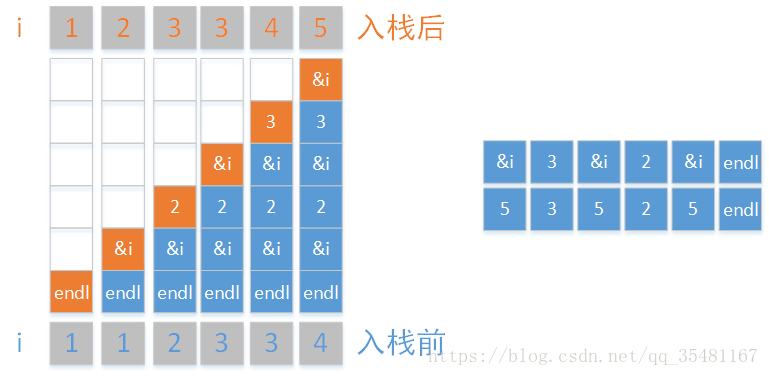
第一步:将 endl 压入栈中, i 值不变; 第二步:将 i 的引用压入栈中, i 的值加 1 变成 2(因为是 ++i ); 第三步:将 2 压入栈中, i 的值加 1 变成 3(因为是 i++ ); 第四步:将 i 的引用压入栈中, i 的值不变(因为是 i ); 第五步:将 3 压入栈中, i 的值加 1 变成 4(因为是 i++ ); 第六步:将 i 的引用压入栈中, i 的值加 1 变成 5(因为是 ++i ); 第七步:将栈里的数据依次弹出,即可得到 53525 。(因为i的值是 5 ,所以所有 i 的引用都是 5 ) 。
方法一:用控制符 dec(十进制),hex(十六进制),oct(八进制) 。
#include <iostream>using namespace std;int main(){ int chest = 42; // decimal integer literal int waist = 0x42; // hexadecimal integer literal int inseam = 042; // octal integer literal cout << "Monsieur cuts a striking figure!"; cout << "chest = " << chest << " (42 in decimal)"; cout << "waist = " << waist << " (0x42 in hex)"; cout << "inseam = " << inseam << " (042 in octal)"; chest = 42; waist = 42; inseam = 42; cout << "Monsieur cuts a striking figure!" << endl; cout << "chest = " << chest << " (decimal for 42)" << endl; cout << hex; // manipulator for changing number base cout << "waist = " << waist << " (hexadecimal for 42)" << endl; cout << oct; // manipulator for changing number base cout << "inseam = " << inseam << " (octal for 42)" << endl; // cin.get(); //有些设备的运行窗口只弹出一下,加上该句可以让窗口停留 return 0; }
运行结果:
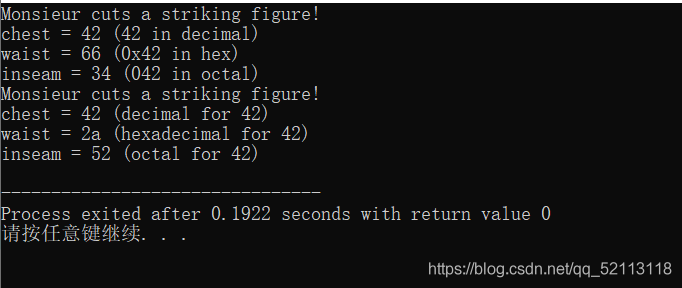
在默认情况下,cout以十进制格式显示整数 。
其中,oct 是八进制输出, dec 是十进制(效果和默认一样), hex 是十六进制输出(字母默认是小写字母)。这两个也包含在 std 中,即其全称分别是 std::oct 、 std::dec 、 std::hex ,这三个控制符包含在库 < iostream > 中.
注意:默认格式为十进制,在修改格式之前,原来的格式将一直有效。(修改后的格式一直有效,直到更改它为止) 。
方法二:使用setbase(n) 。
#include <iostream>#include <iomanip>using namespace std;int main(){ int i = 123456; cout << i << endl; cout << dec << i << endl; cout <<"八进制:" << oct << i << endl; cout <<"十六进制(小写字母):" << hex << i << endl; cout << setiosflags(ios::uppercase); cout <<"十六进制(大写字母):" << hex << i << endl; cout <<"八进制:" << setbase(8) << i << endl; cout <<"十六进制:" << setbase(16) << i << endl;}
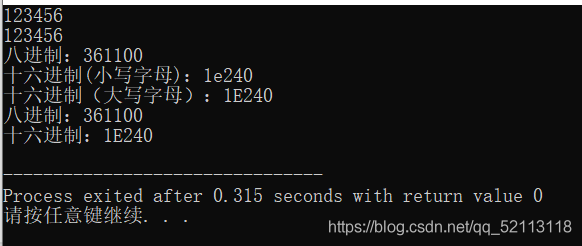
setbase(n) 表示以 n 进制显示,包含在库 < iomanip > 中,n 只能取 8, 10, 16 三个值。 setiosflags(ios::uppercase) 表示将字母大写输出,包含在库 < iomanip > 中。 以上均包含在std 命名空间中.
width函数将长度不同的数字放到宽度相同的字段中,该方法原型为:
int width() 。
int width(int i) 。
第一种格式返回字段宽度的当前设置;第二种格式将字段宽度设置为i个空格,并返回以前的字段宽度值。这使得能够保存以前的值以便恢复宽度值时使用.
注意:width()方法只影响接下来显示的一个项目,然后字段宽度将恢复为默认值.
#include <iostream>using namespace std;int main(){ int w = cout.width(30); cout << "default field width = " << w << ":"; int a; cout.width(10); cout <<cout.width(10) <<endl; //返回当前字段的宽度 cout.width(5); cout << "N" <<":"; cout.width(8); cout << "N * N" << ":"; for (long i = 1; i <= 100; i *= 10) { cout.width(5); cout << i <<":"; cout.width(8); cout << i * i << ":"; } return 0; }
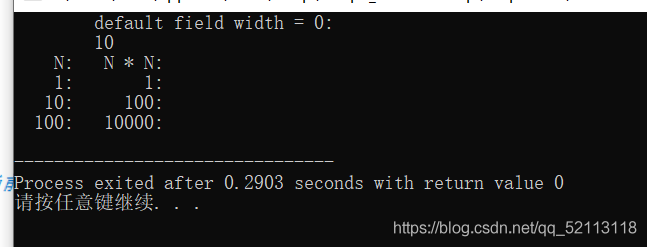
也可以使用setw(int n)来设置输出域宽.
#include <iostream>#include <iomanip>using namespace std;int main(){ cout << "s" << setw(8) << "a" << endl; //s与a之间有7个空格 cout << "s" << setw(3) << "abcd" << endl;}

setw()只对其后面紧跟的输出产生作用,如上例中,表示"a"共占8个位置,不足的7个位置用空格填充.
若紧跟的输出的内容超过setw()设置的长度,输出结果存在问题.
填充字符 。
在默认情况下,cout用空格填充字段中未被使用的部分,可以用fill()成员函数来改变填充字符.
控制符包含在库 < iomanip > 中,std 命名空间中.
#include <iostream>using namespace std;int main(){ cout.fill("*"); const char * staff[2] = { "Waldo Whipsnade", "Wilmarie Wooper"}; long bonus[2] = {900, 1350}; for (int i = 0; i < 2; i++) { cout << staff[i] << ": $"; cout.width(7); cout << bonus[i] << ""; } return 0; }

注意:与字段宽度不同的是,新的填充字符将一直有效,直到更改它为止.
方法一:
C++的默认精度为六位(但末尾的0将不显示)。precision()成员函数使得能够选择其他值,与fill类似,新的精度设置将一直有效,直到被重新设置.
#include <iostream>using namespace std;int main(){ float price1 = 20.40; float price2 = 1.9 + 8.0 / 9.0; cout << ""Furry Friends" is $" << price1 << "!"; cout << ""Fiery Fiends" is $" << price2 << "!"; cout.precision(2); cout << ""Furry Friends" is $" << price1 << "!"; cout << ""Fiery Fiends" is $" << price2 << "!"; return 0; }

方法二:
前提:包含库 < iomanip > ,这个库包含了对输入输出的控制.
#include <iostream>#include <iomanip>using namespace std;int main(){ double i = 3333.1415926; cout << i << endl; cout << setprecision(3) << i << endl; cout << setprecision(9) << i << endl; cout << setiosflags(ios::fixed); cout << i << endl; cout << fixed << setprecision(3) << i << endl; cout << setprecision(9) << fixed << i << endl;}

可以看出,C++默认浮点数输出有效位数是 6 位(若前面整数位数大于 6 位,使用科学计数法输出),而通过以下几种方式可以更改输出精度: 1.使用 setprecision(n) 即可设置浮点数输出的有效位数 (若前面整数位数大于 n 位,使用科学计数法输出) 2.使用 setiosflags(ios::fixed) 或 fixed,表示对小数点后面数字的输出精度进行控制 所以,和 setprecision(n) 结合使用即可设置浮点数小数点后面数字的输出精度,位数不足的补零 以上均采用 “四舍五入” 的方法控制精度,三个控制符均包含在 std 命名空间中.
打印末尾的0和小数 。
#include <iostream>using namespace std;int main(){ float price1 = 20.40; float price2 = 1.9 + 8.0 / 9.0; cout.setf(ios_base::showpoint); cout << ""Furry Friends" is $" << price1 << "!"; cout << ""Fiery Fiends" is $" << price2 << "!"; cout.precision(2); cout << ""Furry Friends" is $" << price1 << "!"; cout << ""Fiery Fiends" is $" << price2 << "!"; // std::cin.get(); return 0; }

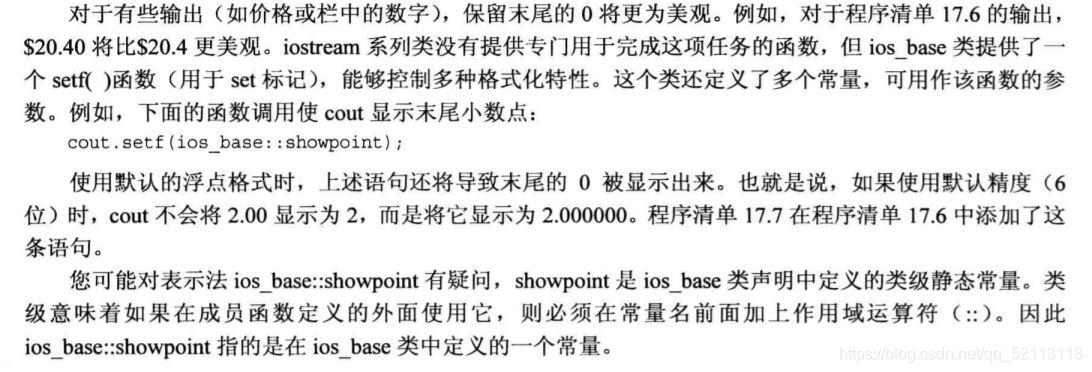
以上就是C++中cout的格式使用的详细内容,更多关于C++ cout格式的资料请关注我其它相关文章! 。
原文链接:https://blog.csdn.net/qq_52113118/article/details/117624247 。
最后此篇关于C++中cout的格式使用详细介绍的文章就讲到这里了,如果你想了解更多关于C++中cout的格式使用详细介绍的内容请搜索CFSDN的文章或继续浏览相关文章,希望大家以后支持我的博客! 。
我需要将文本放在 中在一个 Div 中,在另一个 Div 中,在另一个 Div 中。所以这是它的样子: #document Change PIN
奇怪的事情发生了。 我有一个基本的 html 代码。 html,头部, body 。(因为我收到了一些反对票,这里是完整的代码) 这是我的CSS: html { backgroun
我正在尝试将 Assets 中的一组图像加载到 UICollectionview 中存在的 ImageView 中,但每当我运行应用程序时它都会显示错误。而且也没有显示图像。 我在ViewDidLoa
我需要根据带参数的 perl 脚本的输出更改一些环境变量。在 tcsh 中,我可以使用别名命令来评估 perl 脚本的输出。 tcsh: alias setsdk 'eval `/localhome/
我使用 Windows 身份验证创建了一个新的 Blazor(服务器端)应用程序,并使用 IIS Express 运行它。它将显示一条消息“Hello Domain\User!”来自右上方的以下 Ra
这是我的方法 void login(Event event);我想知道 Kotlin 中应该如何 最佳答案 在 Kotlin 中通配符运算符是 * 。它指示编译器它是未知的,但一旦知道,就不会有其他类
看下面的代码 for story in book if story.title.length < 140 - var story
我正在尝试用 C 语言学习字符串处理。我写了一个程序,它存储了一些音乐轨道,并帮助用户检查他/她想到的歌曲是否存在于存储的轨道中。这是通过要求用户输入一串字符来完成的。然后程序使用 strstr()
我正在学习 sscanf 并遇到如下格式字符串: sscanf("%[^:]:%[^*=]%*[*=]%n",a,b,&c); 我理解 %[^:] 部分意味着扫描直到遇到 ':' 并将其分配给 a。:
def char_check(x,y): if (str(x) in y or x.find(y) > -1) or (str(y) in x or y.find(x) > -1):
我有一种情况,我想将文本文件中的现有行包含到一个新 block 中。 line 1 line 2 line in block line 3 line 4 应该变成 line 1 line 2 line
我有一个新项目,我正在尝试设置 Django 调试工具栏。首先,我尝试了快速设置,它只涉及将 'debug_toolbar' 添加到我的已安装应用程序列表中。有了这个,当我转到我的根 URL 时,调试
在 Matlab 中,如果我有一个函数 f,例如签名是 f(a,b,c),我可以创建一个只有一个变量 b 的函数,它将使用固定的 a=a1 和 c=c1 调用 f: g = @(b) f(a1, b,
我不明白为什么 ForEach 中的元素之间有多余的垂直间距在 VStack 里面在 ScrollView 里面使用 GeometryReader 时渲染自定义水平分隔线。 Scrol
我想知道,是否有关于何时使用 session 和 cookie 的指南或最佳实践? 什么应该和什么不应该存储在其中?谢谢! 最佳答案 这些文档很好地了解了 session cookie 的安全问题以及
我在 scipy/numpy 中有一个 Nx3 矩阵,我想用它制作一个 3 维条形图,其中 X 轴和 Y 轴由矩阵的第一列和第二列的值、高度确定每个条形的 是矩阵中的第三列,条形的数量由 N 确定。
假设我用两种不同的方式初始化信号量 sem_init(&randomsem,0,1) sem_init(&randomsem,0,0) 现在, sem_wait(&randomsem) 在这两种情况下
我怀疑该值如何存储在“WORD”中,因为 PStr 包含实际输出。? 既然Pstr中存储的是小写到大写的字母,那么在printf中如何将其给出为“WORD”。有人可以吗?解释一下? #include
我有一个 3x3 数组: var my_array = [[0,1,2], [3,4,5], [6,7,8]]; 并想获得它的第一个 2
我意识到您可以使用如下方式轻松检查焦点: var hasFocus = true; $(window).blur(function(){ hasFocus = false; }); $(win

我是一名优秀的程序员,十分优秀!